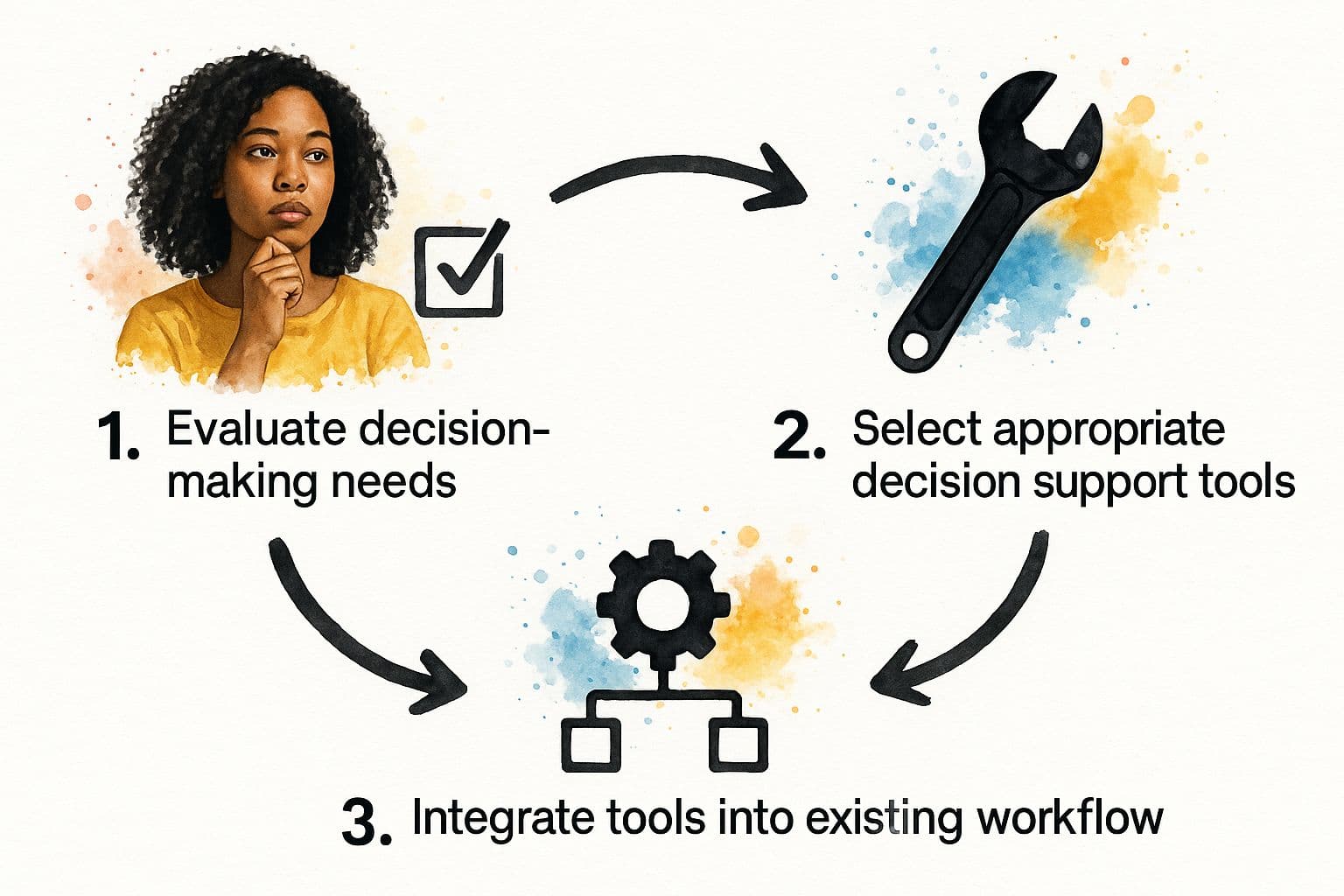Discover proven strategies for faster decision making to boost agility and results. Our guide provides actionable insights for decisive leadership.
July 14, 2025 (4mo ago)
Enhance Business Success with Faster Decision Making
Discover proven strategies for faster decision making to boost agility and results. Our guide provides actionable insights for decisive leadership.
← Back to blog
Let's get one thing straight: making decisions faster isn't about being reckless. It’s about having a smart, structured way to evaluate your options without getting bogged down. The real skill is matching the speed of your decision to the importance of its outcome. This is how high-performing teams keep their momentum and react to new information without grinding to a halt.
The Hidden Costs of Slow Decisions

Indecision does a lot more than just delay a project; it quietly chips away at your ability to compete. Think about it. While one team is stuck in endless loops of "what if," their more agile competitors are already out there, shipping new features, winning customers, and defining the market. This isn't just lost time—it's lost revenue and squandered opportunities.
There’s a term for this: decision velocity**. It’s a measure of how quickly your team can make sound choices, and it's become a critical KPI in today's business environment. When your decision velocity is low, the problems cascade. Team morale takes a nosedive when progress stalls. Frustration mounts, ownership gets murky, and your best people—the ones who want to get things done—start to disengage or even look for jobs elsewhere.
This problem is only getting bigger. We’re all drowning in data. By 2025, the amount of data in the world is expected to reach an incredible 175 zettabytes. Yet, companies that actually figure out how to use their data well see real results, often boosting profit margins by 8-10%. Making fast, data-informed decisions isn't a "soft skill" anymore; it's a fundamental business necessity. You can dive deeper into some of these surprising analytics stats to grasp the full impact.
Indecision is often more costly than a wrong decision. An imperfect choice that gets you moving can be corrected, but the opportunities lost while standing still are gone forever.
Before you can speed things up, you have to know what's slowing you down. Most teams run into the same familiar roadblocks.
Here’s a quick look at the most common bottlenecks I’ve seen and the core ideas for breaking through them.
Common Decision Bottlenecks and Their Solutions
| Bottleneck | Core Principle for Resolution |
|---|---|
| Analysis Paralysis | Set a deadline for the decision. Accept that "good enough" and moving is often far better than waiting for "perfect." |
| Unclear Ownership | Every key decision needs one, and only one, accountable owner. This eliminates confusion and buck-passing. |
| Fear of Failure | Create a culture where smart, well-intentioned mistakes are seen as chances to learn, not reasons to punish. |
| Information Silos | Get your critical data into one place where all the key players can access and understand it easily. |
Recognizing these patterns in your own workflow is the first, most important step. Once you see the bottleneck, you can start applying the right principle to clear it.
How To Pinpoint Your Decision Bottlenecks

Before you can speed anything up, you have to play detective. The first job is to uncover those hidden points of friction that stall momentum and create frustrating delays. From my experience, these bottlenecks are rarely obvious until you go looking for them.
I once worked with a marketing team that was brilliant but constantly missing campaign launch dates. Their problem wasn't a lack of great ideas; it was a painfully slow approval process. Multiple stakeholders all had to give their sign-off, but no one was the ultimate owner. This created a dizzying cycle of revisions and delays that just drained the team's energy.
It wasn't until we mapped out the entire approval flow, from concept to launch, that the bottleneck became crystal clear: diffused ownership.
I saw a similar thing with an engineering team struggling to prioritize new features. Their debates would drag on for weeks with no end in sight. The root cause? They lacked a single, shared source of truth for user requests and impact data. Decisions were being made based on loud opinions, not hard evidence.
Conduct an Analysis Paralysis Audit
To find your own team's sticking points, a great place to start is with what I call an Analysis Paralysis Audit. This is really just a focused way of asking tough questions to diagnose what’s holding you back.
Think about a recent decision that took far too long. Get the team together and dig into it with these questions:
- Who owned it? Was there a single person responsible for making the final call? If the answer is vague—like "the committee" or "everyone"—you’ve found a huge bottleneck.
- What was missing? Did we have all the information we needed to feel confident? If not, why? Was the data unavailable, stuck in a silo, or just not trustworthy?
- Was it fear? Be honest. Was the delay truly because we needed more information, or was it a fear of being wrong?
Acknowledging the need for good, accessible data is a massive step. Research shows that while 73% of organizations know that real-time analytics are critical, only 42% have actually managed to implement the capabilities. This gap highlights just how common data-related delays are. You can read more about these and other decision-making predictions to see the broader trends.
Figuring out if your problem is structural (ownership), informational (data), or cultural (fear) gives you a clear target for improvement. After all, you can't fix a problem you can't see. This audit is all about gaining the visibility you need to take real, effective action.
Actionable Frameworks for Rapid Decision Making
Spotting the bottlenecks is one thing, but actually fixing them requires a system. This is where a solid framework comes in—it gives your team the structure to make decisions faster without letting quality slip. These aren't just abstract theories; they're proven methods used by some of the most nimble companies out there.
One of the most powerful models I've seen in action comes from Amazon, and it's built on a beautifully simple idea: categorizing choices as either Reversible or Irreversible. Getting this right is a total game-changer for team velocity.
- Irreversible Decisions (Type 1): These are the one-way doors. Think big, high-stakes moves that are tough, if not impossible, to walk back—like acquiring another company or launching a flagship product. These rightly demand careful, slow deliberation and a mountain of data.
- Reversible Decisions (Type 2): Thankfully, most business decisions fall into this bucket. They're two-way doors. If you make a call and it doesn't pan out, you can simply walk back through and try something else. Running a new A/B test or tweaking a marketing campaign are perfect examples. These choices should be made fast, often with just "good enough" information.
The biggest mistake I see teams make is treating every single decision like it's a Type 1. This creates analysis paralysis over choices that carry very little long-term risk. Once you teach your team to see the difference, you empower them to act decisively on the 95% of issues that come up every day.
Adopt Time-Boxing and Clear Ownership
Another fantastic technique is Time-Boxing Decisions. Instead of letting a choice hang in the air forever, you give it an explicit deadline. This creates a healthy pressure that forces everyone to focus on getting to a conclusion instead of endlessly chasing what-ifs. Applying solid prioritization techniques to boost productivity is also key here, making sure the most important decisions get the attention they deserve.
I once advised a startup that used this method to get their MVP out the door months ahead of schedule. Rather than getting bogged down debating every little feature, they gave themselves a single week to lock in the core feature set. It forced them to make some tough calls, but it got them moving.
The final piece of this puzzle is assigning a Single-Threaded Owner for every key decision. You need one person who is ultimately on the hook for making the final call. This doesn't mean they operate in a silo, but it completely eliminates the dreaded "death by committee" scenario. When everyone knows who the decider is, the entire process becomes instantly clearer and much, much faster.
This flow chart breaks down how to think about evaluating and integrating these kinds of frameworks and tools into your team's day-to-day.

As the visual shows, success isn't about luck. It’s about being deliberate in matching the right methods to your specific challenges.
Using The Right Tools For Data-Driven Speed

Even the most robust decision-making frameworks are useless if they're running on bad or incomplete information. Getting faster at making decisions isn't about guesswork; it’s about getting your hands on the right data, exactly when you need it. For most teams I've worked with, the biggest hurdle is information silos—that frustrating state where crucial metrics are trapped in different departments and a dozen different software tools.
Modern tools are built to tear down these walls. Picture a centralized dashboard where sales numbers, marketing campaign results, and customer support trends all live together. Instantly, the whole dynamic changes. You’re no longer stuck waiting days or weeks for separate teams to pull their numbers and build their reports. The information is right there, live and ready to go.
Turning Data Into Action
Let's walk through a real-world scenario. A product team is holding its monthly review meeting. Instead of passing around outdated spreadsheets, they open a real-time dashboard in Fluidwave. They immediately see that a new feature has a fantastic engagement rate, but it's also the source of most new support tickets.
Armed with this insight, they can make a quick, well-informed call. The entire conversation pivots from "What do we think is going on?" to "What's our plan to act on this data?" In that single meeting, they can form a small task force dedicated to improving that feature’s user experience. That’s what happens when you turn raw data into actionable intelligence on the spot.
This kind of agility is precisely why so many businesses are looking into how to use AI for knowledge management, which can automate how information is organized to surface insights for faster choices.
The goal of technology in this context is simple: reduce the time between an event occurring and your team making a confident decision about it. Every minute saved from hunting down information is a minute that can be spent on execution and innovation.
Ultimately, your tools should support your decision-making framework, not the other way around. By bringing in a platform that acts as a single source of truth, you give your team the clarity they need to act with conviction. You can find more on achieving this kind of clarity in our other expert project management tips for high-performing teams.
Building a Culture of Confident Action
Let's be honest. You can have the best decision-making framework in the world, but it's doomed to collect dust if your company culture is ruled by fear. True progress comes down to the people making the calls, and that requires an environment of psychological safety.
I’ve seen it happen time and again: when teams are terrified of being blamed for a well-intentioned misstep, they stop taking smart risks. Instead, they’ll default to the safest, slowest, and often least effective path forward. Decision paralysis sets in.
The change has to start at the top. Leadership must openly celebrate the lessons learned from decisions that didn't go as planned. Think of these moments not as failures, but as tuition paid for valuable market intelligence. The critical question shouldn't be, "Whose fault is this?" It needs to be, "What did we learn, and how will we apply that knowledge next time?"
This simple shift in perspective can transform your entire organization. Instead of chasing the impossible standard of 100% certainty, you're encouraging your team to act with agility and confidence, armed with enough information to make a smart move.
Foster Empowerment and Clarity
Of course, empowerment without clear boundaries is just chaos. One of the most powerful things you can do to build confident action is to clearly define who owns which decisions. It’s a simple act, but it cuts through the ambiguity that causes people to hesitate, wondering if they're about to overstep.
This clarity is a cornerstone of a high-performing team. Weaving in effective strategies for enhancing overall productivity can amplify the impact of these cultural changes, creating a truly efficient workflow.
"In any moment of decision, the best thing you can do is the right thing, the next best thing is the wrong thing, and the worst thing you can do is nothing." - Theodore Roosevelt
By establishing clear roles, you create a system where individuals feel secure in their responsibilities and are empowered to act. This level of focus is crucial, and you can find practical methods for sharpening it in our guide on how to focus better at work.
When you give your team both the psychological safety to act and the clarity of ownership, you build a sustainable culture where faster, more confident decisions become the norm, not the exception.
Tackling the Tough Questions About Making Decisions Faster
When you start introducing new ways to speed up decision-making, it’s only natural for questions and a bit of uncertainty to pop up. Let's walk through some of the most common concerns I hear from teams and get you some practical answers.
How Can We Move Faster Without Being Reckless?
This is the big one. The goal isn't recklessness; it's about being smart and adaptable. The trick is to learn the difference between decisions you can easily walk back and those you can't.
Not every choice is a life-or-death moment for the business. A new social media campaign? That’s a two-way door—if it doesn’t work, you can pull it, adjust, and try something else. The cost of a misstep is low. A major capital investment in new machinery, on the other hand, is a one-way door. Once you walk through it, there's no turning back without a significant loss.
The key is matching your decision-making rigor to the gravity of the outcome.
The most common mistake is treating every choice like it's irreversible. This leads to analysis paralysis over small issues. Empowering your team to recognize the difference is a game-changer for velocity.
What If We Lack Real-Time Data?
Perfect, real-time data is a luxury, not always a reality. Don’t let its absence bring everything to a halt. Instead, focus on what you can control: shrinking the time it takes to gather and analyze the data you do have access to.
Set up a consistent rhythm for reviewing key metrics, whether that's daily, weekly, or bi-weekly. Just as importantly, make sure there's one person who is clearly responsible for owning that data and presenting the insights. This creates a predictable flow of information, even if it isn't instantaneous.
How Should We Handle Disagreements?
Disagreements are not just normal; they're a sign of a healthy, engaged team. The problem isn't the debate itself, but when it drags on without resolution. This is where you need a clear framework.
I'm a big fan of the "disagree and commit" model. It gives everyone a chance to voice their concerns and present their arguments. But once the designated decision-maker makes the final call, the entire team gets behind it—no second-guessing or "I told you so's." This is crucial when you need to learn how to manage competing priorities and move forward as a cohesive unit.
Ready to eliminate decision bottlenecks and empower your team with clarity? Fluidwave provides a centralized platform to track data, assign ownership, and execute with confidence. Get started for free today.
Focus on What Matters.
Experience lightning-fast task management with AI-powered workflows. Our automation helps busy professionals save 4+ hours weekly.